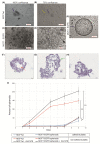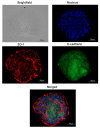EGFR Transgene Stimulates Spontaneous Formation of MCF7 Breast Cancer Cells Spheroids with Partly Loss of HER3 Receptor
- PMID: 34884742
- PMCID: PMC8657849
- DOI: 10.3390/ijms222312937
EGFR Transgene Stimulates Spontaneous Formation of MCF7 Breast Cancer Cells Spheroids with Partly Loss of HER3 Receptor
Abstract
Multicellular spheroids with 3D cell-cell interactions are a useful model to simulate the growth conditions of cancer. There is evidence that in tumor spheroids, the expression of various essential molecules is changed compared to the adherent form of cell cultures. These changes include growth factor receptors and ABC transporters and result in the enhanced invasiveness of the cells and drug resistance. It is known that breast adenocarcinoma MCF7 cells can spontaneously form 3D spheroids and such spheroids are characterized by high expression of EGFR/HER2, while the natural phenotype of MCF7 cells is EGFRlow/HER2low. Therefore, it was interesting to reveal if high epidermal growth factor receptor (EGFR) expression is sufficient for the conversion of adherent MCF7 to spheroids. In this study, an MCF7 cell line with high expression of EGFR was engineered using the retroviral transduction method. These MCF7-EGFR cells assembled in spheroids very quickly and grew predominantly as a 3D suspension culture with no special plates, scaffolds, growth supplements, or exogenous matrixes. These spheroids were characterized by a rounded shape with a well-defined external border and 100 µM median diameter. The sphere-forming ability of MCF7-EGFR cells was up to 5 times stronger than in MCF7wt cells. Thus, high EGFR expression was the initiation factor of conversion of adherent MCF7wt cells to spheroids. MCF7-EGFR spheroids were enriched by the cells with a cancer stem cell (CSC) phenotype CD24-/low/CD44- in comparison with parental MCF7wt cells and MCF7-EGFR adhesive cells. We suppose that these properties of MCF7-EGFR spheroids originate from the typical features of parental MCF7 cells. We showed the decreasing of HER3 receptors in MCF7-EGFR spheroids compared to that in MCFwt and in adherent MCF7-EGFR cells, and the same decrease was observed in the MCF7wt spheroids growing under the growth factors stimulation. To summarize, the expression of EGFR transgene in MCF7 cells stimulates rapid spheroids formation; these spheroids are enriched by CSC-like CD24-/CD44- cells, they partly lose HER3 receptors, and are characterized by a lower potency in drug resistance pomp activation compared to MCF7wt. These MCF7-EGFR spheroids are a useful cancer model for the development of anticancer drugs, including EGFR-targeted therapeutics.
Keywords: 3D cell culture; EGFR; HER3; MCF7; cancer stem cells; drug resistance; spheroids.
Conflict of interest statement
The authors declare no conflict of interest.
Figures







References
-
- Kaprin A.D., Starinsky V.V., Shahzadova A.O. The State of Cancer Care for the Population of Russia in 2019. National Medical Research Radiological Centre of the Ministry of Health of the Russian Federation; Moscow, Russia: 2020.
-
- Lohberger B., Glaenzer D., Eck N., Steinecker-Frohnwieser B., Leithner A., Rinner B., Kerschbaum-Gruber S., Georg D., Lohberger B., Glaenzer D., et al. Effects of a Combined Therapy of Bortezomib and Ionizing Radiation on Chondrosarcoma Three-Dimensional Spheroid Cultures. Oncol. Lett. 2021;21:1–10. doi: 10.3892/ol.2021.12689. - DOI - PMC - PubMed
Publication types
MeSH terms
Substances
Grants and funding
LinkOut - more resources
Full Text Sources
Research Materials
Miscellaneous

